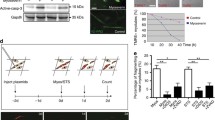Abstract
The commonly accepted hypothesis explaining the control of skeletal muscle differentiation is that all myogenic precursor cells are equivalent and that they differentiate into post-mitotic muscle cells in response to exogenous signals, specifically low mitogen concentrations1,2. Large clones derived from vertebrate myogenic cells, however, consist both of cycling precursors and of terminally differentiated, post-mitotic muscle cells3–7. Here, we count the total number of cells and the number of terminally differentiated cells (or nuclei, in fused cells) in large myogenic clones. The number of terminally differentiated cells per clone was usually equal to or just below a multiple of 16. This finding is not expected from a model postulating a homogeneous population of muscle precursor cells. Rather, our results suggest that a self-renewing stem cell exists in the skeletal muscle lineage. This cell can generate committed precursors which then give rise to cohorts of 16 terminally differentiated muscle cells. This model of myogenesis provides a simple explanation for the protracted and asynchronous nature of muscle differentiation in vertebrate embryogenesis.
Similar content being viewed by others
References
Konigsberg, I. R. Devl Biol. 26, 133–152 (1971).
Konigsberg, I. R. in Pathogenesis of the Human Muscular Dystrophies (ed. Rowland, L.P.) 779–798 (Elsevier, Amsterdam, 1977).
Konigsberg, I. R. Science 140, 1273–1284 (1963).
Linkhart, T. A. & Hauschka, S. D. Devl Biol. 69, 529–548 (1979).
Hauschka, S. D. Devl Biol. 37, 329–344 (1978).
Abbott, J., Schiltz, J., Dienstman, S. & Holtzer, H. Proc. natn. Acad. Sci. U.S.A. 71, 1506–1510 (1974).
Quinn, L. S., Nameroff, M. & Holtzer, H. Expl Cell Res. 154, 65–82 (1984).
Kligman, D. & Nameroff, M. Expl Cell Res. 127, 237–247 (1980).
Quinn, L. S. & Nameroff, M. Differentiation 24, 111–123 (1983).
Quinn, L. S. & Nameroff, M. Differentiation 24, 124–130 (1983).
Robinson, M., Quinn, L. S. & Nameroff, M. Differentiation 26, 112–120 (1984).
Sternberger, L. A. Immunocytochemistry(Wiley, New York, 1979).
Capers, C. R. J. biophys. biochem. Cytol. 7, 559–566 (1960).
Caplan, A. I., Fiszman, M. Y. & Eppenberger, H. M. Science 221, 921–927 (1983).
Houseman, D. & Levenson, R. Cell 25, 5–6 (1981).
Alberts, B. et al. Molecular Biology of the Cell (Garland, New York, 1983).
Devlin, R. B. & Emerson, C. P. Cell 13, 599–611 (1978).
Holtzer, H., Marshall, J. M. & Finck, H. J. biophys. biochem. Cytol. 3, 705–723 (1957).
Okazaki, K. & Holtzer, H. J. Histochem. Cytochem. 13, 726–739 (1965).
Yeoh, G. C. T. & Holtzer, H. Expl Cell Res. 104, 63–78 (1977).
O'Neill, M. C. Devl Biol. 53, 190–205 (1976).
Devlin, B. H., Merrifield, P. A. & Konigsberg, I. R. in Muscle Development. Molecular and Cellular Control (eds Pearson, M. L. & Epstein, H. F.) 355–366 (Cold Spring Harbor Laboratory, New York, 1982).
Dienstman, S. R. & Holtzer, H. in Results and Problems in Cell Differentiation (eds Reinert, J. & Holtzer, H.) 1–25 (Springer, New York, 1975).
Holtzer, H. in Stem Cells and Tissue Homeostasis (eds Lord, B. I., Potten, C. S. & Cole, R. J.) 1–28 (Cambridge University Press, 1978).
Nadal-Ginard, B. Cell 15, 855–864 (1978).
Linkhart, T. A., Clegg, C. H. & Hauschka, S. D. Devl Biol. 86, 19–30 (1981).
Author information
Authors and Affiliations
Rights and permissions
About this article
Cite this article
Quinn, L., Holtzer, H. & Nameroff, M. Generation of chick skeletal muscle cells in groups of 16 from stem cells. Nature 313, 692–694 (1985). https://doi.org/10.1038/313692a0
Received:
Accepted:
Issue Date:
DOI: https://doi.org/10.1038/313692a0
- Springer Nature Limited
This article is cited by
-
The organelle of differentiation in embryos: the cell state splitter
Theoretical Biology and Medical Modelling (2016)
-
Differentiation of activated satellite cells in denervated muscle following single fusions in situ and in cell culture
Histochemistry and Cell Biology (2005)
-
Myosatellite cells of Cyprinus carpio (Teleostei) in vitro: isolation, recognition and differentiation
Cell and Tissue Research (1990)





